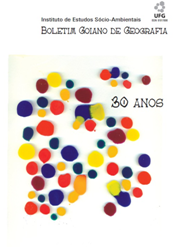VULNERABILITY OF SOILS AND NATURAL WATERS OF THE STATE OF GOIÁS TO THE CONTAMINATION BY VINASSE USED IN FERTIGATION OF SUGAR CANE CULTURE
DOI:
https://doi.org/10.5216/bgg.v30i1.11202Abstract
Sugar cane production has increased in the State of Goias, Central Brazil. This growth may imply environmental concerns because sugar cane processing will generate large amounts of vinasse, a nutrient-rich liquid waste that is often used to improve soil fertility. However, vinasse may be a contaminant when applied to soils as a fertilizer. The objective of this paper was to evaluate the natural vulnerability of soils and surface and subsurface waters to chemical contamination by vinasse. To carry out the research, an integrated spatial analysis of slope steepness, soil type and hidraulical conductivity was performed to determine the degree of vulnerability of lands (soil and water) to be contaminated by vinasse. Four degrees of land vulnerability were chosen (very high, high, medium, low) and those correlated with sugar cane processing plants to define potential contamination scenarios. The results showed that areas with very high and high vulnerability was about 57%, which indicates the lands of the State of Goiás are highly vulnerable to pollution by vinasse, if the waste is not properly managed.
Downloads
Downloads
Published
How to Cite
Issue
Section
License
Authors will not receive any payment for publishing their work in Boletim Goiano de Geografia. Therefore, they must grant all rights to the journal. However, they are entirely and exclusively responsible for the published contents, and editors are free to make corrections or adjustments to texts in conformity with publication guidelines.







